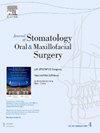扩展腮腺切除术后重建复杂面神经缺损的新方法:颌面神经和舌下神经降支。
IF 1.8
3区 医学
Q2 DENTISTRY, ORAL SURGERY & MEDICINE
Journal of Stomatology Oral and Maxillofacial Surgery
Pub Date : 2024-09-19
DOI:10.1016/j.jormas.2024.102085
引用次数: 0
摘要
本研究旨在介绍一种利用颌面部神经和舌下神经降支重建复杂面神经缺损的新技术。在此,我们报告了一例局部晚期腮腺恶性肿瘤患者接受扩大腮腺切除术并切除受侵面神经的病例。肿瘤切除后,面神经近端无法进入,导致形成多个远端分支缺损。随后,我们利用颧神经和颊上神经的腮腺分支以及舌下神经的颊下分支和颌下分支重建了复杂的面神经缺损。手术和术后均未发现明显并发症。随访 18 个月后,患者的面部功能已恢复到 House-Brackmann-III 级。总之,这种双神经转位方法被证明是重建扩大腮腺切除术后复杂面神经缺损的有效方法。本文章由计算机程序翻译,如有差异,请以英文原文为准。
A novel method to reconstruct the complex facial nerve defect after extended parotidectomy with masseteric nerve and descending hypoglossal nerve
This study aims to present a novel technique for reconstructing complex facial nerve defects using the masseteric nerve and descending hypoglossal nerve. Here, we report a case involving a patient with locally advanced parotid malignancy who underwent extended parotidectomy with resection of the invaded facial nerve. Following tumor resection, the proximal end of the facial nerve was inaccessible, leading to the formation of multiple distal branch defects. Subsequently, we performed reconstruction of the complex facial nerve defect using the masseteric nerve for the zygomatic and upper buccal branches and the descending hypoglossal nerve for the lower buccal and submandibular branches. There were no significant operative or post-operative complications observed. Upon 18 months of follow-up, the facial function of the patient had been restored to House-Brackmann-III grade. In conclusion, this dual nerve transposition approach proves to be an effective method for reconstructing complex facial nerve defects subsequent to extended parotidectomy.
求助全文
通过发布文献求助,成功后即可免费获取论文全文。
去求助
来源期刊

Journal of Stomatology Oral and Maxillofacial Surgery
Surgery, Dentistry, Oral Surgery and Medicine, Otorhinolaryngology and Facial Plastic Surgery
CiteScore
2.30
自引率
9.10%
发文量
0
审稿时长
23 days
 求助内容:
求助内容: 应助结果提醒方式:
应助结果提醒方式:


